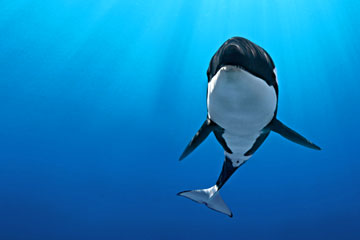
Gabriela cowperthwaite had long considered trips to SeaWorld San Diego with her twin boys a good parent's duty. Who doesn't love Shamu? Then in February 2010, an experienced trainer at SeaWorld Orlando, Dawn Brancheau, was killed by an orca named Tilikum, who drowned her and tore her body apart in front of horrified families. "I couldn't understand how Dawn Brancheau came to be killed by an animal that we consider to be our friend," Cowperthwaite tells me.
That question is at the heart of her new film, Blackfish. At first Cowperthwaite believed Brancheau's death was an anomaly. But Tilikum, now estimated to be 32, had been linked to two other deaths since he was captured off the eastern coast of Iceland in 1983. An investigation by the Occupational Safety and Health Administration (OSHA) after Brancheau's death into the hazards faced by the trainers found evidence of 100 dangerous interactions between captive orcas and SeaWorld trainers. (In 2012 a federal judge upheld OSHA's finding that SeaWorld trainers could no longer perform stunts in the water with the orcas; barriers are required.) Blackfish became more than the story of a freak accident. Like the Oscar-winning 2009 documentary The Cove, about the inhumane practices involved in the acquisition of dolphins for amusement parks, it makes a strong case that the human desire for proximity to these mammals, specifically in amusement-park settings, is selfish at best and morally indefensible at worst.
Blackfish is as evenhanded as can be expected given SeaWorld's refusal to participate (more on that later), but it's a troubling and crushingly sad tale. I sank lower and lower in my chair as I watched a mother orca keening for the baby taken from her and as Tilikum's backstory grew more ominous. Cowperthwaite tracks down a pair of sisters who say they watched Tilikum drown a trainer at Canada's now defunct Sealand of the Pacific in 1991. There were two female whales with him; the sisters say Tilikum, the biggest of the three, was the aggressor.
But Tilikum is not depicted as some Jaws-like outlier. Blackfish suggests that killer whales, with their complex brains (containing, as one scientist explains in the film, emotional centers that humans don't have) are being driven over the edge by the constraints of captivity. In the wild, they remain with their family units--moving villages in the deep blue. "I do believe that 40 years ago, when we began this mad-scientist experiment, we were trying to reach across the species veil or curtain and make a friend on the other side," Cowperthwaite says. "But what we learned in those four decades is that there is no way we can possibly give them what they need."
She supports this thesis in Blackfish with scientific perspectives and some startling mea culpas. A diver who helped catch some of the first whales brought into captivity in 1970 says, "This was the worst thing I've ever done." When John Hargrove, 39, who left SeaWorld in 2012 on disability, speaks of Brancheau, a friend, his voice still breaks as he reflects on her last minutes. "I know she had to have been thinking, I'm going to turn this around," he tells me. Hargrove was anxious about appearing in Blackfish. "I had to get over the programming that we all have at SeaWorld," he says. "What we are taught is, Don't you ever speak out, because you are going to hurt the whales."
